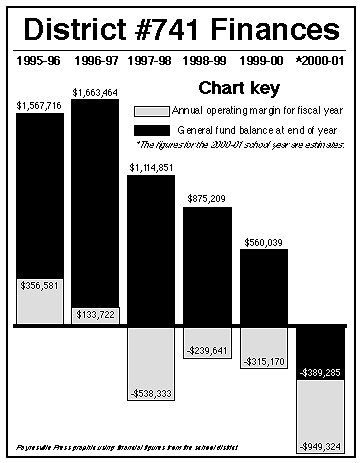Ten years ago
It has been ten years since the school district made major budget cuts for financial reasons. The board was given a handout on the cuts from 1990.
Facing a budget deficit, the district approved its first excess levy referendum of $248 per pupil in 1989, which generated $186,102 per year for five years. Increasing enrollment also raised additional funds for the district.
In 1990, the district approved cutting $150,000 from the budget. With the additional revenue, that was enough to erase a budget deficit of $463,639.
In making those cuts, the board was presented with more than 40 possible items to cut, which totaled $350,000. The board approved cutting 28 items which resulted in a net savings of $150,000 to the district.
Since then, district voters have approved two more excess levy referendums. The second excess levy referendum of $339.50 per pupil unit raised $348,000 per year. It passed in November 1993. With debt equalization in effect, the district paid for 20 percent and the state paid 80 percent.
Voters approved a 10-year excess levy for $488,389 per year in November 1997. This levy raises $315 per pupil unit. Of the total, only $128,511 is raised locally and state equalization aid covers 75 percent or $359,878.
Timeline for budget cuts
Nov. 27-28, 2000: District begins exploring budget cuts. School board approves timeline for making cuts.
Dec. 2000 to Jan. 15, 2001: Information gathering by the administration.
Jan. 16 to Jan. 31: Information review by the board.
Feb. 1: Public hearing to discuss possible cuts.
Feb. 1 to Feb. 16: Board analyzes input from hearing.
Return to Archives
 Superintendent Howard Caldwell doesn't believe the deficit will be as great as projected once the audit is completed. "There are dollars in program areas that are not always spent. I feel we will have funds in some of the reserve funds at the end of the fiscal year," he said.
Superintendent Howard Caldwell doesn't believe the deficit will be as great as projected once the audit is completed. "There are dollars in program areas that are not always spent. I feel we will have funds in some of the reserve funds at the end of the fiscal year," he said.